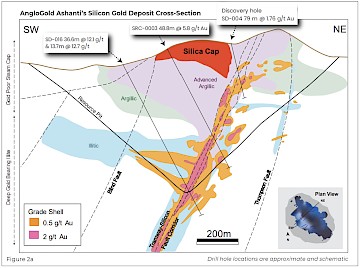Location, Infrastructure, History and State of Exploration
The Celts property is in southeastern Nevada (Figure 1) and is comprised of 67 unpatented claims (560-hectare) It is located 13 kilometers northeast of the historic town of Goldfields on the NE edge of the Goldfields district, which has an endowment of approximately 5.5 Moz of gold. (John and Henry, 2020, LLC website 12-11-2019 (https://gemfieldresources.com/about-the-goldfield-project/)
The Celts property can be accessed by maintained non-paved county roads off State Highway 95, which is the main highway connecting Tonopah, Goldfields, Beatty, and Las Vegas. The property itself has several non-maintained dirt roads that access the existing shafts.
The Celts property has two historic shafts on, and adjoining the property, the Gold Button shaft, which is part of the property, and the Nancy Donaldson shaft, which lies on patented claims adjoining the SW corner of the current Celts property (Margerson, 1986, Celts-technical-presentation-september-17-2024 (orogenroyalties.com)). Eminent has not yet located any information about the quantity of gold produced, albeit the size of the dumps indicates that a significant amount of rock was brought to the surface. Chevron, in 1986 and 1987 explored disseminated mineralization in the hanging wall of the mineralized structure hosting the Gold Button shaft (Margerson, 1986, Chevron, 1987). In 1986, Chevron performed limited grid-based geochemistry (mercury gas), IP/resistivity and VLF presumably along the mineralized structure that hosts the Gold Button vein - their claim block did not cover the rhyolite dome or steam cap (Margerson, 1986). Neither the map nor the results of this study are available. In 1987, Chevron drilled five shallow holes in the hanging wall of the mineralized structure hosting the Gold Button shaft, achieving a high value of 1.5 m of 4.1 g/t Au, 400 meters north of the shaft itself (Chevron, 1987). None of Chevron’s work tested the conceptual model that Orogen and Eminent are pursuing.
The land on which the Celts property lies remained fallow until 2022, when Orogen Royalties noted the geologic similarity between the Silicon deposit, one of the most significant recent discoveries in Nevada, and the Celts property (Figure 2, Celts-technical-presentation-september-17-2024, orogenroyalties.com). Orogen Royalties, under it’s previous name Renaissance Exploration Inc., had originally staked the Silicon property in 2017 (AngloGold Ashanti, 2023) due to the presence of a rhyolite hosted steam cap consisting of advanced argillic alteration (alunite and kaolinite) and silica (Figure 2A, Celts-technical-presentation-september-17-2024, orogenroyalties.com). AngloGold Ashanti purchased the Silicon property from Renaissance Exploration and subsequently discovered 3.4 M oz of indicated and 800K oz inferred gold resources. (AngloGold Ashanti, 2023). After the discovery of the Silicon resource, AngloGold went on to discover a much larger deposit within the Orogen AOI called the Merlin resource (9.05 Moz inferred gold resource) which together with the Silicon resource comprise the expanded Silicon Project (AngloGold Ashanti, 2023). Subsequently, the same team at Renaissance Exploration (now Orogen Royalties) that had originally located the Silicon property began looking for other similar steam caps in similar rhyolite host rocks. They used both satellite and ground based hyperspectral techniques to explore for advanced argillic alteration (alunite and kaolinite). The features at the Celts property were very similar to that of the expanded Silicon property (Figure 2B, Celts-technical-presentation-september-17-2024, orogenroyalties.com) and thus Orogen staked the property. Over the next few years 77 rock chip samples and 113 infrared spectral samples were taken at the Celts Property (Orogen Royalties, private database).









